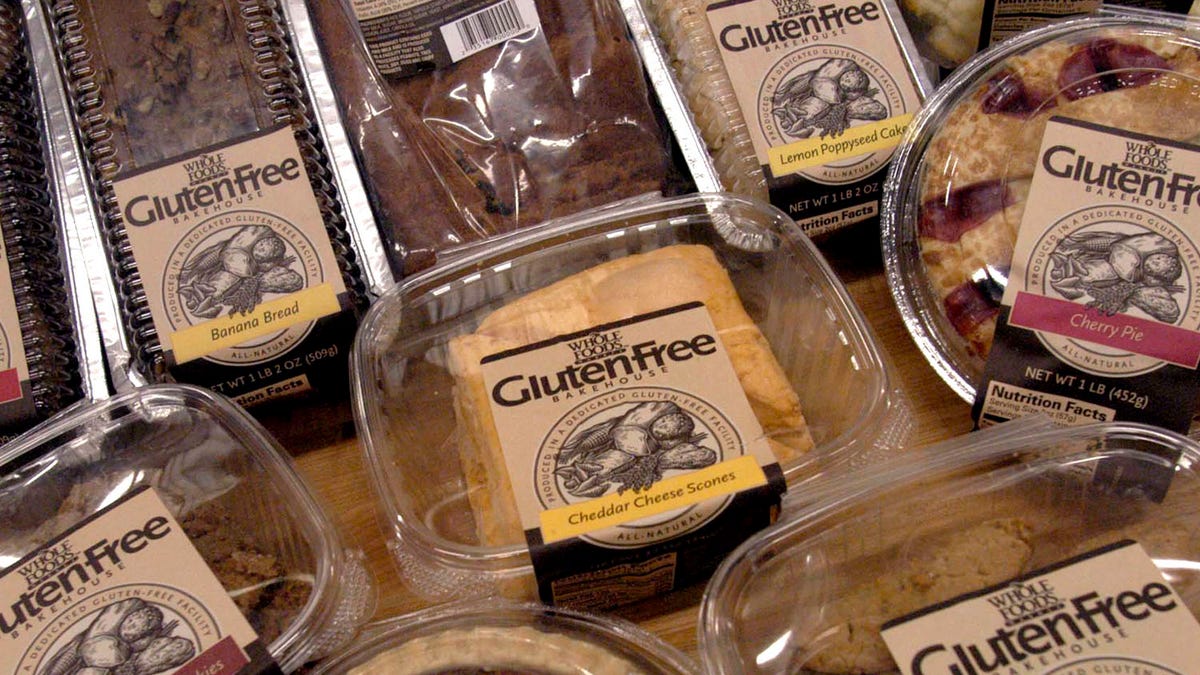
** FILE ** A sample of some of the 27 gluten-free products are displayed, in this Oct. 5, 2004 file photo, at the Whole Foods Market Gluten-Free Bakehouse in Morrisville, N.C. Each label reads "Produced in a Dedicated Gluten-Free Facility." Once banished to the dusty bottom shelves of obscure grocers, the gluten-free revolution is surfacing in the aisles of major supermarkets. (AP Photo/Karen Tam) (AP)
Are you one of the nearly 46 percent of people who avoid gluten because you think that gluten-free products are “healthier,” or one of the 30 percent who eat gluten-free to manage their weight?
If you’re doing this for the reasons mentioned above, unfortunately, you may end up increasing your grocery budget and your belly. Think $7 loaves of bread and gluten-free chips.
“Unless someone is diagnosed with celiac disease or gluten intolerance by a physician or discovers through a food-elimination diet that they feel better without gluten, there is no good reason to avoid it,” says Carol Fenster, author of 125 Gluten-Free Vegetarian Recipes (2011).
In reality, only 1 percent of Americans have celiac disease. Only 6 percent have non-celiac gluten sensitivity.
There’s a significant difference between being diagnosed with celiac disease and having gluten sensitivity. Fenster explains “that the first one is an auto-immune condition where gluten damages the small intestine’s ability to absorb nutrients, while the second one it causes symptoms but not necessarily the same as celiac disease.”
Health at Risk
Tricia Thompson, MS, RD, nutrition consultant Celiac Disease, adds that “a gluten-free diet, as typically followed, may be high in fat and low in fiber and many vitamins and minerals, including iron, calcium, folate, and niacin. Many prepared gluten-free foods are made from refined flours (white rice flour, milled corn) and starch (corn starch, tapioca starch) and as a result contain very little in the way of nutritional value.”
In this regard, Fenster mentions that one concern is to rely on processed gluten-free foods, which are high in calories and low in important nutrients.
“Potato chips and French fries are gluten-free but not necessarily the healthiest options,” she says.
Regardless, the industry is claiming many benefits of eating gluten-free, ranging from stopping hip pain to a better sleep.
Fenster says some people may experience these benefits because they could have an underlying intolerance to gluten that hasn’t been diagnosed. Oftentimes it’s the other ingredients in food with gluten that is to blame, such as dairy, corn or eggs that cause the problem, but gluten gets blamed. People could also lose weight on a gluten-free diet because gluten is usually present in high-calorie items such as baked goods, pasta, desserts.
“People would lose weight by eliminating these foods whether gluten was present in the foods or not,” says Fenster.
Powerful grains
Both experts agree that someone who takes the gluten-free diet as a way to eat fresher, unprocessed food, more vegetables and fruits, legumes and whole grains will not just nourish his or her body but also may achieve her or his weight goals. This is the staple of any health diet.
In reality, coping with true gluten intolerance requires a lifelong commitment. This is not the latest diet, it’s a way of living. Meanwhile, whether for health reasons or not, be adventurous and add to your diet nutritious gluten-free grains such as amaranth, buckwheat, corn, millet, quinoa or sorghum. These grains can provide protein, fiber and plenty of vitamins and minerals to be a healthy addition of any type of diet.
A truly healthy gluten-free recipe
Autumn Buckwheat Porridge
Serves 4
Recipe from: Lisa Roberts-Lehan, Certified Health and Nutritional Consultant, and Holistic Chef
1 cup whole buckwheat
2 cups water
2 cinnamon sticks
1 vanilla pod
? cup raisins
? cup goji berries
? cup sunflower seeds
1 tablespoon honey
Milk (or non-dairy milk)
Rinse the buckwheat in water. Add buckwheat, water, cinnamon sticks, vanilla pod, raisins, goji berries, and a pinch of salt in a pot and boil it on low heat for about 20 minutes. Stir occasionally until the water is gone. Remove the cinnamon sticks and vanilla pod. Serve with unsweetened almond milk, sunflower seeds and honey.
Marta Montenegro inspires people to live healthy lives by giving them the tools and strength to find one’s inner athlete through her personal website MartaMontenegro.com. She created SOBeFiT, a national fitness magazine for men and women, and the Montenegro Method DVD workout series – a program she designed for getting results in just 21 days by exercising 21 minutes a day . Marta is a strength and conditioning coach and serves as an adjunct professor of exercise physiology at Florida International University.
Follow us on twitter.com/foxnewslatino
Like us at facebook.com/foxnewslatino
